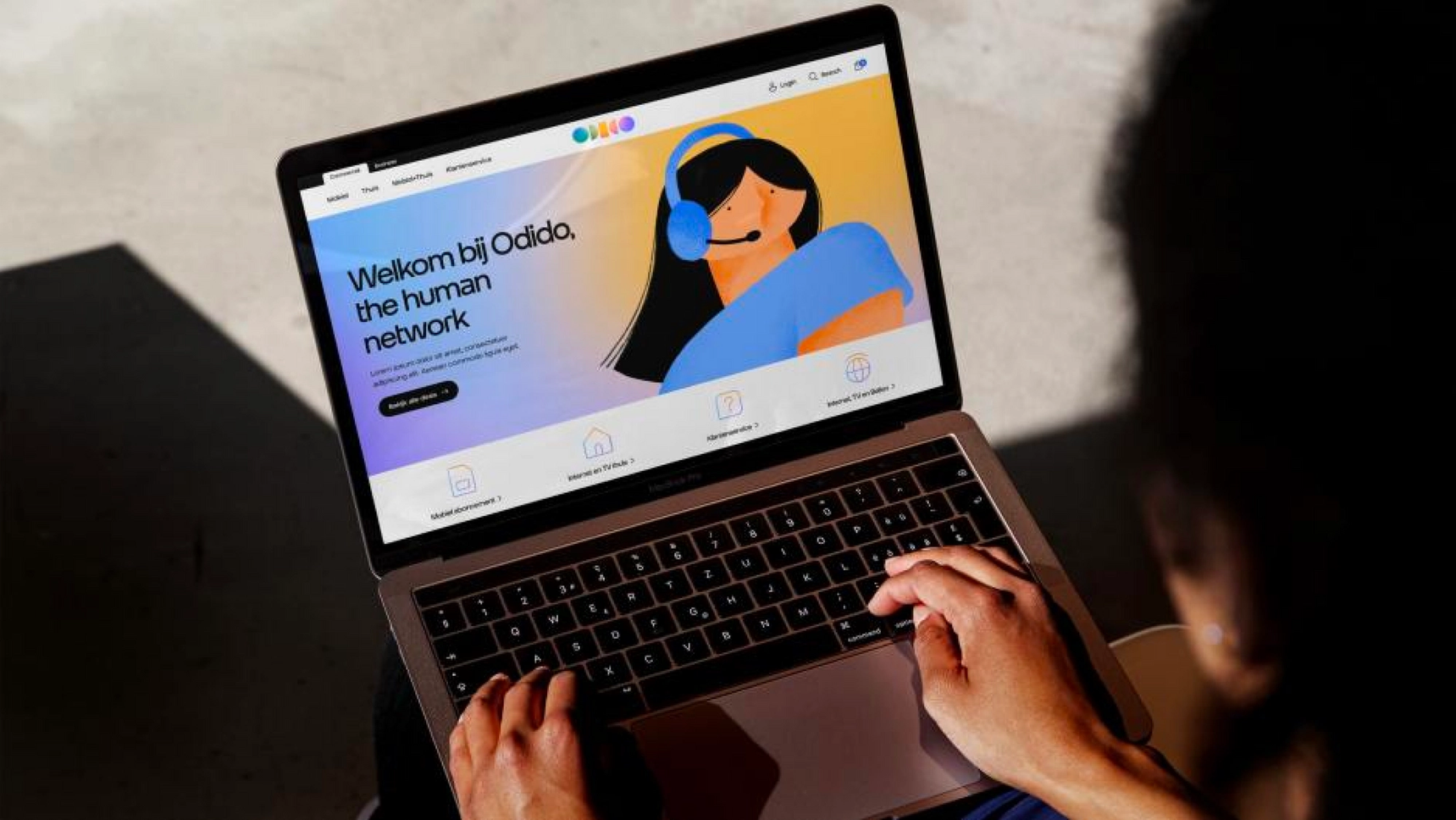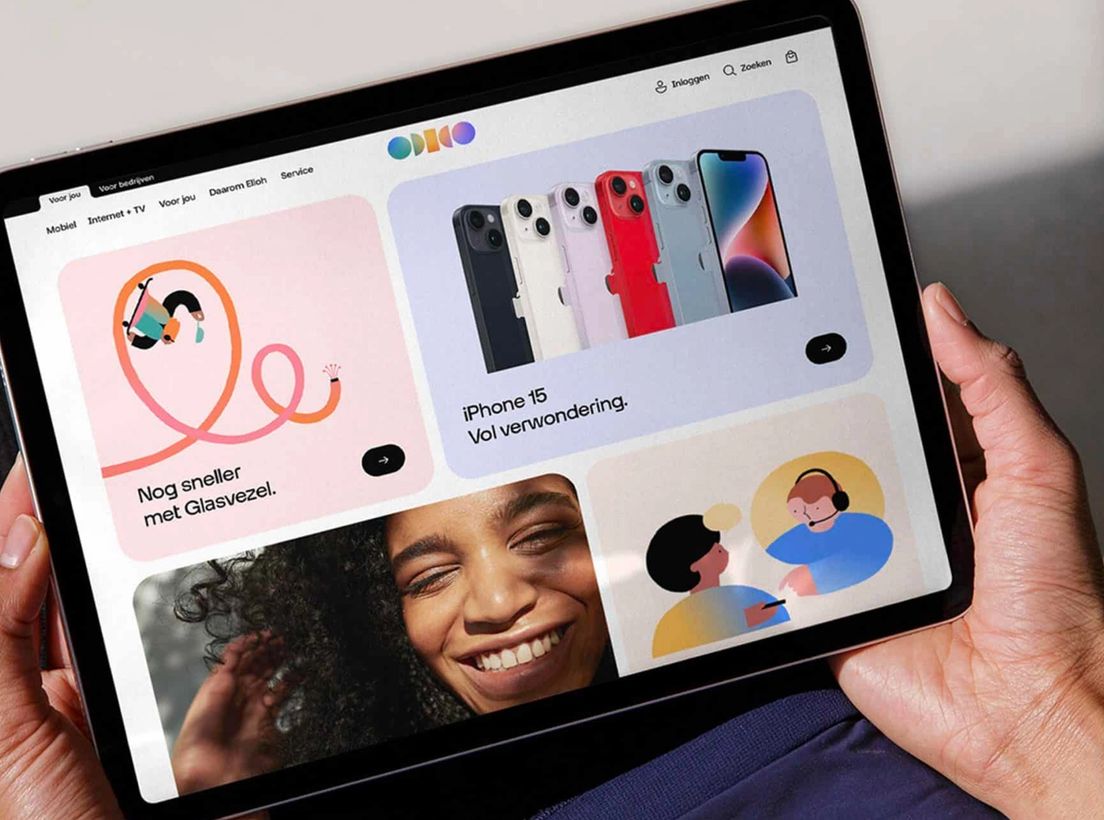How Odido’s active brand language will help it thrive in the experience age
I wonder if there has ever been a more exciting time to work in brand strategy. We have left behind the first wave of digital transformation. Shifting our focus from building digital services that work, to experiences that are ownable and distinctive. The strategies that we write have evolved from informing narratives to giving direction and meaning to every interaction people have with companies. Brand strategy has the potential to be the aggregator for driving the experience economy. Finally delivering on the idea that Pine and Gilmore coined almost 25 years ago.
Except, the reality is that we are not.
Forester reported that less than 1 in 5 companies use their brand as the basis for their customer experience. A staggering statistic. Equity that corporations have carefully built over decades has somehow lost its relevance in the digital realm. And it was exactly this insight that started the conversations about how to do that differently for Odido. With the opportunity to build a brand from scratch, we collectively wanted to build a brand that was progressive. Digital and experience first. To create a springboard that could bridge the chasm between marketing and CX teams and projects. And to retain the relevance of brand thinking, and more importantly; build value and distinction of Odido, by better connecting these two DNA’s. To do that, we focussed on 2 key challenges.
Creating ownership
The first challenge is that with the evolution of digital, we gravitated towards managing touchpoints instead of stewarding ownership. There is no denying that managing the perception of brands has become more challenging in the experience age. Brands have transitioned to being a driver for hundreds of interactions across web, app and customer service. And a wide variety of content. Some push, some pull and some user generated. It is easy to see how brands have become a mosaic of all these different experiences.
However, it is not so much the growing number of touchpoints that has impacted brand building, but the change in ownership. The reign over brand by the marketing department has long crumbled and has been transferred to a wide variety of touchpoint owners across many layers of organizations. From client service employees to product owners. Many of them are not trained marketers, let alone brand specialists. Making consistency a challenging feat.
What we often fail to deliver to them is an actionable strategy that they can work with. We use language and models only understood by brand specialists, but do not resonate or travel beyond that. We have to admit that brand keys are not remotely interesting for anyone outside of brand strategy.
Countering the commoditization of user centricity
The second challenge is that we should stop the fixation on customer centricity and bring back a healthy balance between customer need and brand role. Because this fixation has completely commoditized digital services and jeopardizes brand distinctiveness. With all the attention going to what people want, we have forgotten to think about what problems are uniquely ours to solve. And what makes our solutions different from our competitors.
Even though every experience department has built elaborate journeys based on data and research, they are likely looking at roughly the same problems. And without applying a proper brand lens, they are creating the exact same solutions as their competitors. Go to the webshop of H&M, compare it to Prada, and you would be hard pressed to find any difference beyond price. Remove the colours of any telco app and I challenge you to guess which one you are looking at. Why do the online configurators of BMW, Mercedes and Audi work roughly the same? Because we are not thinking about how our brands would solve a problem from their perspective. If BMW is about driving pleasure and Audi is about technological innovation, their configurators should be completely different. Regardless of the fact that people want to play around with car models and specs.

Active vs. passive brands
To resolve these challenges we need to understand the difference between passive and active brands. We tend to write a lot of passive brand statements, suitable to create narratives, but not solutions. Passive brands help to define identities. They lean on archetypes and storytelling and mainly come to life in brand films and stories, built by advertising agencies. But in general they struggle to inspire action. With no clear and understandable role for the people who need to work with it.
One of the simplest examples of that is if you compare two well known slogans from McDonalds and Burger King. ‘I’m lovin it’ needs a whole world of communication to bring it to life, but it does nothing for me if I am behind the counter of a restaurant. Or anywhere else besides advertising for that matter. Compare that to ‘Have it your way’ and you can instantly see that this is a clearer role. Even if I don’t read the brand book, I still know what my role is in serving customers at Burger King.
Active brand language solves our two key challenges: it empowers everyone in an organization to add to a consistent and distinctive experience. It creates ownership. You don’t need a degree in strategy and branding to help bring the brand to life. And it narrows down the essence of what the brand is solving for its clients. It adds guidance to what problems it should focus on to not end up in a sea of sameness. A well defined active brand helps your entire organization solve the problems that are relevant to your brand alone. That is what the ambition was for Odido.
Developing an active brand
The recipe for active brands is not as complicated as you might think, but it does require a shift in thinking. As a brand owner, you need to be razor-sharp about what need you are solving for your audience and what your company can do on a continuous basis to solve that need. This combination should be universal but ownable. ‘Have it your Way’ taps into the need for customization, and in essence individuality, in a one-size-fits-all world of fast food.
At Hypersolid we have developed tons of service innovations for KLM as we were trying to be the most caring airline in the world. Tapping into the need of being recognized as a person instead of a passenger. Caring is a far more engaging need than just good customer service or the comfort of your seat. In the Netherlands, an electronics retailer called Coolblue is beating its far larger rival MediaMarkt with their incredible service built on ‘Everything for a smile’. It reigns supreme over MediaMarkts ‘Always in search for the wow for you’’. Sure, there are other more fundamental reasons why the latter did not work out. But it also left too much room for interpretation. What is the need behind this wow and how do I create solutions that solve it? While everything for a smile cannot be more clear in terms of need and opportunity to act.
For Odido we helped identify the need to keep up with technology, and more specifically: the joy of taking part when you can actually keep up. With a clear role for Odido: doing everything in our power to make technology human. Because it is the increasing complexity of tech and the removal of the human aspect that makes it harder to take part. Why talk about 12 megapixels when you can show how great your pictures will turn out to be? We can explain download speeds or the capacity of a Snapdragon chip, or we can visualize what speeds are good for texting versus online gaming. A simple role like fighting to keep technology human can spark all kinds of ideas from all parts of the organization. Only fueled by the very active line ‘Het kan ook zo’ developed by TBWA\NEBOKO.
There are tons of other examples of brand lines that capture this balance between need and opportunity to act. ‘Belong anywhere’, ‘Think Different’, ‘We Try Harder’. It does not take much to understand what you need to build based on these foundations. Active brand statements pave the way for an endless amount of exciting solutions that an organization can build, and distinctive services that it can offer. That is what we as brand strategists should strive to create. Making everyone a custodian of distinction and bringing brand thinking back on the backlog. Will it solve the problem entirely? No. Together with Odido we are excited to keep working on better integrating product and brand. But at least we will have created future ready foundations carried by the entire organization. I am confident that the rest will follow suit.
Industry insights, company updates, and groundbreaking achievements. Stories that drive Hypersolid forward.
Solid change starts here


